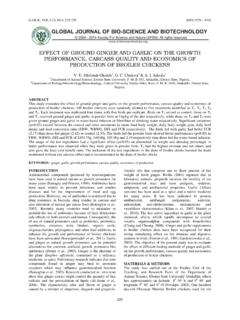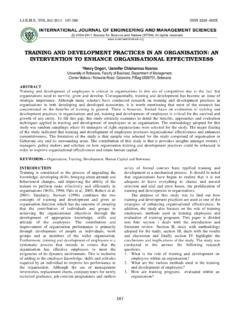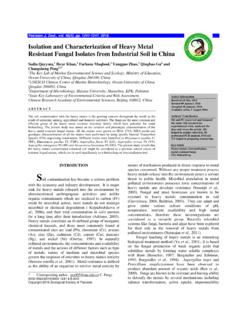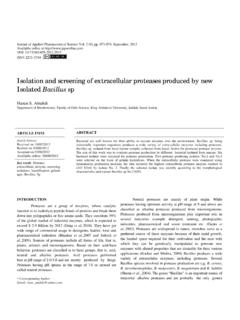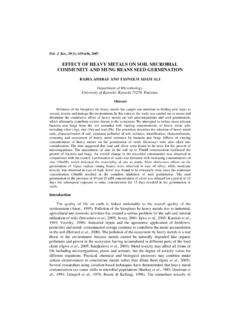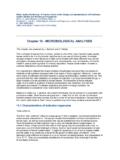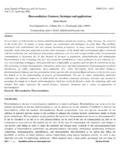Transcription of ISOLATION AND SCREENING OF PHOSPHATE SOLUBILIZING …
1 , (3)2013: 438-441 ISSN2278 9103438 ISOLATION AND SCREENING OF PHOSPHATE SOLUBILIZINGBACTERIA FROM sunflower RHIZOSPHERED. Patel& *P. ParmarDepartment of Biosciences, Veer NarmadSouth Gujarat University, Surat-395007, Gujarat, India.*Corresponding Author is one of the major nutrients which play an indispensable biochemical role in photosynthesis, respiration,energy storage and transfer, cell division, cell enlargement and several other processes in the living plant. Chemicalfertilizer is the main source of plant available phosphours in the agriculture soils, but almost 75 to 90% of addedPhosphate fertilizer is precipitated by iron, aluminum and calcium complexes present in the soils.
2 Many soil bacteria andfungi have the ability to solubilizephosphate minerals and make it available to plants. Thus, an attempt was made toisolate and screen potential PHOSPHATE SOLUBILIZING bacteria (PSB) which can able to solubilize PHOSPHATE and be used asbiofertilzer in future. sunflower plant rhizosphere soil samples from the different sites of Surat, Bharuch district ofGujarat was collected and each sample was enriched in Pikovskaya s medium, pH at 27oC for 5 days. About 78isolates were obtained on same agar medium. From that 11 isolates were found tobe good PHOSPHATE solubilizer.
3 Theseisolates were coded as PSB1, PSB2, PSB3, PSB4, PSB5, PSB6, PSB7, PSB8, PSB9, PSB10 and PSB11. Each purifiedisolate was studied for zone of solubilization and quantitative PHOSPHATE solubility by Pikovskaya s agar andchlorostannous reduced molybdophosphoric acid blue method respectively. Among the isolates PSB5 gives maximumsoluiblization zone (18 mm) followed by PSB 9 (14 mm) and PSB6 (12 mm). However, the isolate PSB2 and PSB7showed the least solubilization zone. The PHOSPHATE released by the strain ranged from 68 mg/l to 181 mg/l. Among theisolates PSB 5, PSB9, PSB6, PSB8, PSB11 and PSB10 were to be potential strain to solubilize the insoluble WORDS: PHOSPHATE SOLUBILIZING bacteria (PSB),Pikovskaya s medium, Molybdophosphoric method, sunflower plantrhizosphereINTRODUCTIONP hosphorus is a biocritical element in short supply innature.
4 Phosphorus plays an indispensable biochemicalrole in photosynthesis, respiration, energy storage andtransfer, cell division, cell enlargement and several otherprocesses in the living plant (Gyaneshwaret al., 2002).Soils are often high in insoluble minerals and organicphosphates but deficient in organophosphates (Pi)(Grover, 2003). In India, majority of the phosphorusprovided in the formof chemical fertilizers whichabundant use decreases the fertility of soil after longperiod of time. In nature, wide range of microbialbiosolubilization mechanisms exist which are necessary tomaintain global cycle (Whitelaw, 2000).
5 Manymicroorganismsare able to solubilize unavailable formsof phosphates by excreting organic acids. These microbespresent in the different forms and numbers in the soil(Kucey, 1983). A large number of bacteria includingspecies ofPseudomonas, Azospirillum, Azotobacter,Klebsiella, Enterobacter, Alcaligenes, Arthrobacter,Burkholderia, Bacillus, RhizobiumandSerratiahavereported to enhance plant growth by with their differentplant growth promoting activities including phosphatesolubilization (Kumaret al., 2012) . The hydroxyl andcarboxyl groups of microbial organic acid chelate thecations bound to PHOSPHATE , thereby converting it intosoluble forms (Kpomblekou and Tabatbhai, 1994).
6 However, PHOSPHATE solubilization is a complexphenomenon, which depends on many factors such asnutritional, physiological and growth conditions of theculture (Reyeset al., 1999). Literature reviews indicatesthat an average of 108 CFU per gram of PhosphateSolubilizingBacteria (PSB) was found in fertile soil offorests, organic farming and rhizosphere (Widawatiet al.,2004; Widawati and Suliasih, 2006; Widawati andSuliasih, 2009). PHOSPHATE SOLUBILIZING microbes can alsoproduce phosphatase enzyme which can benefitsustainable organic farming systems especially in coastalecosystems, and reduce the utilization of agrochemicals inagricultural fields (Widawati,2011).
7 In themicroorganisms bacteria can grow faster than fungus andactinomyces by utilizing simple , an attemptwas made to isolate and screen potential phosphatesolubilizing bacteria from the soil for the AND METHODSSoil samplingThe soil samples were collected from differentagricultural land of villages ofSurat and Bharuch districtlocated in Gujarat, India. Soil samples were collectedfrom the rhizosphere of sunflower plant. The sampleswere carefully collected in polythene bags and stored at4oC of PHOSPHATE SOLUBILIZING bacteria (PSB)from rhizosphere soilSoil samples were prepared by inoculating of eachsoil into 100ml of sterile distilled water.
8 Homogenizationof soil was carried out by keeping it on shaker for 30minutes at 120 rpm at 27oC temperature. After 30minutes,samples were removed aseptically and438 PHOSPHATE SOLUBILIZING bacteria from sunflower rhizosphere439centrifuged at 10,000 rpm for 15 minutes. 10ml ofsupernatant was inoculated into 100ml of sterilePikovaskaya s broth and kept it at 120rmp at roomtemperature for 5 days for enrichment. After 5 days, serialdilutionof the enriched medium was carried out andaliquots of serially diluted soil samples were subjected tospread on sterile Pikovaskaya s agar medium(Ponmurugan and Gopi, 2006).
9 Pikovaskaya s mediumcontains (grams/liter); Glucose, ;Ca3(PO4)2, ;(NH4)2SO4, gm;NaCl, gm; , , pH 2. These plates were kept at 27 2oC for 24 to48 hrs. Bacterial colonies were purified by using fourflametechniqueon nutrient media. Each culture wasmaintained at of Potential PHOSPHATE SOLUBILIZING BacteriaEach of the isolates was screened for their ability tosolubilize calcium PHOSPHATE present in thePikovaskaya smedium (Pikovaskya, 1948; Guptaet al., 1994). A loopfulof pure culture was placed on the center of the same agarplates and incubated for27 2oC for 5 days. Thesolubilization zone was determined by subtracting thediameter of bacteria colony from the diameter of estimation of soluble PHOSPHATE inPikovaskaya s brothThe isolates showing zone of solubilziation onPikovaskaya s agar were further examined for their abilityto release PHOSPHATE in broth media.
10 Thus, ( , ) of each isolates culture (18hrs old) was inoculatedseparately into 100ml of sterilePikovaskaya s broth in the250ml Erlenmeyer flasks. Each flask was incubated at28 2 C at 120 rpm for 5 days. Simultaneously, theuninoculated control was also kept under similarconditions. All the experiments were carried out intriplicate. To estimate the amount of PHOSPHATE releasedby the isolates, 10ml of each sample was withdrawn atregular intervals of 24 hrs and was examined for solublephosphorus and pH. The cultures were harvested bycentrifugation at 10,000 rpm for 15 minutes.
